Mastering Blackjack: Winning Strategies and Insights
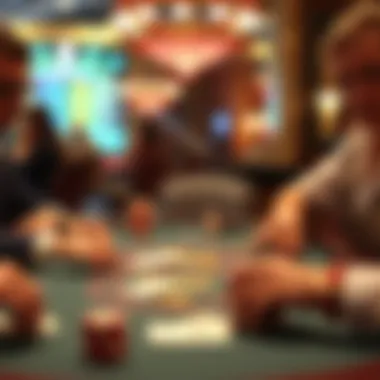

Intro
Blackjack is more than just a game of chance; it’s a dance of strategy, intuition, and psychological insight. The allure of the blackjack table pulls countless players, each drawn by the promise of victory after victory. However, many walk away empty-handed, not realizing that the key to success lies deep within the rules and nuances of the game.
In this guide, we'll explore not just the essentials that every beginner needs to know, but also the advanced tactics that seasoned players can leverage for a competitive edge. We’ll delve into the math that underpins every decision you make, the psychology of both yourself and your opponents, and offer tools to ensure that your experience remains enjoyable and safe.
"The house always wins, but smart players can tilt the odds in their favor."
Game Strategies
Understanding the game is crucial, yet succeeding at blackjack requires more than just knowing the rules. To truly master this game, one must adapt and evolve through different strategies.
Essential Tips for Beginners
For newcomers, the blackjack table can seem intimidating. Here are some essential tips to set you on the right path:
- Learn the Basic Strategy: This is a set of guidelines that tells you when to hit, stand, double down, or split. Websites like Wikipedia provide basic strategy charts.
- Understand the Odds: Familiarize yourself with the concepts of probability. For example, the dealer has a slight edge due to acting last, but knowing how to play your hand can mitigate this.
- Manage Your Bankroll: Setting limits is vital. Decide beforehand how much you're willing to lose and stick to that amount. Never gamble funds that you cannot afford to lose.
- Stay Calm and Focused: Emotional decisions can lead to mistakes. Take your time, and if you feel pressured, consider stepping away.
Advanced Tactics for Seasoned Players
If you’re well-versed in the game and looking to step up your game, consider these advanced techniques:
- Card Counting: While not foolproof, understanding the card distribution can give you an edge. Techniques like the Hi-Lo system can help keep track of high and low cards remaining in the deck.
- Shuffle Tracking: This involves predicting where certain cards will land after the dealer shuffles. It requires a good memory and observation skills.
- Bet Sizing: Adjust your bets depending on your confidence in the hand and the likelihood of winning based on previous rounds. This is often referred to as "betting variance."
- Psychological Play: Reading your opponents can provide insights. If you notice someone sweating over their cards, perhaps they’re holding a weak hand.
Responsible Gaming
Recognizing Problem Gambling
While blackjack can be a thrilling pursuit, it’s crucial to be aware of the fine line between enjoyment and dependency. Recognizing the signs of problem gambling is the first step to maintaining a healthy relationship with the game.
- Increased frequency of play.
- Experiencing escalation in bets on losses.
- Hiding gambling habits or lying about time spent playing.
Tools and Resources for Safe Gambling
There are numerous tools available to help maintain a responsible gaming practice:
- Self-Exclusion Programs: Many casinos and online platforms offer programs that allow you to voluntarily ban yourself from gambling.
- Support Groups: Organizations such as Gamblers Anonymous provide community support.
- Counseling Services: Trained professionals can help address underlying issues that contribute to problem gambling.
For more information, consider visiting sites like Gamblers Anonymous or your local gambling authority's website.
By equipping yourself with both the strategies for success and an awareness of responsible gambling, you can enjoy the intricate game of blackjack to its fullest while potentially increasing your chances of returning home a winner.
Understanding the Basics of Blackjack
Understanding the basics of blackjack is crucial for anyone looking to improve their performance at the table. This foundational knowledge serves to demystify the game, allowing new players to grasp not just how to play, but also why certain strategies are effective. Knowledge empowers players to make educated decisions, which often separates the casual gambler from those who play smart.
Grasping the essence of blackjack involves more than just memorizing rules; it’s about cultivating an appreciation for the dynamics of the game. A player who understands blackjack's nuances will be more adept at spotting opportunities to leverage their play, whether they are seated at a physical casino or engaging in online platforms.
The Objective of the Game
The primary goal in blackjack is straightforward: to beat the dealer without exceeding a total of 21. This fundamental aim shapes every decision made during gameplay. Players are dealt two cards and must choose to take more cards (hit), stop (stand), double their bet (double down), or split their hand into two separate hands (split). The strategic choices made in pursuit of this objective are pivotal; recognizing the dealer's potential hand, understanding when to take risks, and reading the flow of the game can significantly impact outcomes.
It’s interesting to note that strategies can shift based on the dealer’s face-up card. For example, if the dealer shows a weak card like a 4, 5, or 6, commonly referred to as a bust card, players may have a greater reason to stand on lower totals since the dealer risks busting. This kind of insight is vital.
Gameplay Overview and Mechanics
Let’s break down how a typical game unfolds. After all players place their bets, both the dealer and players are dealt two cards. The dealer's cards usually include one face-up (known as the upcard) and one face-down (the hole card). This combination adds an element of suspense, especially for the players trying to determine the dealer's hand strength.
During a player's turn, they can choose one of the following actions:
- Hit: Drawing another card to improve their total.
- Stand: Keeping their current total for that round.
- Double Down: Doubling their original bet and receiving one more card.
- Split: If the first two cards are of the same value, splitting them into two separate hands.
The mechanics are simple on the surface, yet involve layers of calculations related to odds and potential outcomes. Players must try to maintain a hand total closer to 21 than the dealer’s, and also consider the risk of busting. With each play, math and probabilities come into play, meaning that success often lies in understanding the numbers and making calculated choices.
The Importance of Card Values
In blackjack, understanding card values is as critical as knowing the rules. The cards from 2 through 10 are valued as their face value, while the face cards—Kings, Queens, and Jacks—are each valued at 10. Notably, Aces can be worth either 1 or 11, based on what advantage players seek. This flexibility with Aces allows players to create high totals without immediately sacrificing a winning hand.
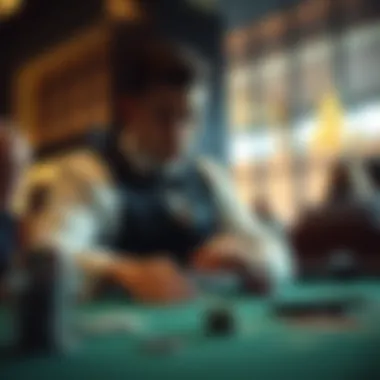

Here are some key points regarding card values:
- Totaling hands effectively: A player might hold an Ace and a 10, giving them the coveted blackjack. With this total, they often secure a higher payout unless the dealer has the same.
- Dealer’s play: The dealer must follow specific rules, generally hitting until reaching 17. Recognizing this can help players gauge their risk when deciding to hit or stand.
- Soft vs. Hard Hands: A hand containing an Ace valued at 11 is considered 'soft' (e.g., Ace-6 = soft 17), whereas a hand without it is 'hard' (e.g., 10-8 = hard 18). Understanding this difference impacts strategy choices drastically.
In summary, mastering these essential facets of blackjack not only makes you a capable player but shifts your experience from basic understanding to strategic engagement. With a solid grasp of objectives, gameplay, and the significance of card values, you’re well on your way to elevating your blackjack skills.
"Knowledge is power; understanding blackjack can turn that power into success at the table."
For further reading, consider exploring resources at Wikipedia and Britannica for deeper insights.
The House Edge and Player Advantage
When it comes to blackjack, the house edge isn’t just a term tossed around in casino circles. It fundamentally shapes the game and a player’s long-term profitability. The house edge reflects the statistical advantage that the casino has over the players, a necessary evil that keeps the lights on and the tables running. Understanding this concept is pivotal for anyone who seeks to thrive at the blackjack table. If players can grasp how it works, they can better devise moves that mitigate that edge and, if lucky, turn the tables in their favor.
Understanding the House Edge
The house edge in blackjack is often expressed as a percentage, which tells you the house’s average profit from each bet compared to your winning potential. For instance, most blackjack games come with a house edge ranging from 0.5% to 2%, depending on the specific rules in play and how well you adapt to them.
This means that for every $100 wagered, the house typically retains $0.50 to $2 if you play with a basic strategy.
One crucial consideration that contributes to this edge is the rules associated with the game, including:
- Blackjack Payouts: Traditional payouts for a natural blackjack are 3 to 2, but some casinos may offer a lower payout, like 6 to 5, affecting the edge significantly.
- Dealer Rules: Whether the dealer hits or stands on a soft 17 impacts the odds in their favor.
- Surrender Options: The availability of surrender—allowing players to forfeit half their bet after seeing the initial hand—can also alter the house edge inversely.
Mastering how these rules affect the house edge allows players to tailor their strategy to diminish its impact.
Ways to Minimize the House Advantage
Even if the house edge seems formidable, there are ways players can reduce its impact and enhance their chances for success. Some effective strategies include:
- Learning Basic Strategy: Familiarize yourself with a basic strategy chart that dictates the best way to play every possible hand.
- Choosing the Right Game: Seek out tables with favorable rules, such as those offering higher payouts for blackjacks or allowing the player to surrender.
- Avoiding Insurance Bets: The insurance bet may seem enticing, but it typically has a high house edge in the long run.
- Mixing Up Your Gameplay: Use varied betting patterns without being too predictable, potentially interfacing psychological tactics as well.
It’s important to remember that controlled play isn't just about winning; it's about setting yourself up for longer-term results.
By actively working to minimize the house advantage, players can better navigate the ups and downs of blackjack while laying a stronger foundation for success. With every decrease in the house edge, the player gains a bit more of an advantage, inching closer to that elusive victory at the tables.
Basic Strategy: The Foundation of Winning
In the grand tapestry of blackjack, a robust understanding of Basic Strategy stands as an essential pillar for anyone looking to tilt the odds in their favor. This strategy is not just a collection of random plays but a carefully designed framework that offers players the highest probability of winning through statistically sound decisions. When executed properly, Basic Strategy minimizes the house edge considerably, giving players a fighting chance against the casino.
The Importance of Basic Strategy
The essence of Basic Strategy lies in its reliance on probability and statistical analyses rather than gut feelings or emotional decision-making. Players equipped with this knowledge can make calculated choices based on their hand total and the dealer's visible card.
Doing so truncates mishaps that arise from rash choices driven by excitement or fear. For instance, instead of blindly hitting when holding a total of 16 against a dealer's 10, Basic Strategy urges players to stand, thus optimizing their chances based on sound mathematical principles. These calculations have been derived from extensive simulations, making them reliable for diverse playing conditions.
Moreover, Basic Strategy is relatively straightforward to grasp. The learning curve is not steep, allowing players, even those new to the game, to start implementing these strategies quickly. Learning the basics can be the difference between a casual player and a serious contender.
Creating a Basic Strategy Chart
A Basic Strategy Chart acts as a roadmap for decision-making during gameplay. This chart delineates the optimal actions based on the player's total and the dealer’s face-up card. Here’s a simplified version of the chart:
- When to Hit: If your total is less than 12 and the dealer shows 7 or higher.
- When to Stand: If you have a total of 17 or higher, regardless of the dealer's card.
- When to Double Down: If your total is 11 and the dealer shows anything below 10.
- When to Split: Always split a pair of Aces or 8s but never split 10s.
While this chart is merely a snapshot, players can find various comprehensive charts online tailored to different game rules and conditions. For an in-depth look, a reputable source like en.wikipedia.org can offer more intricate strategies.
Key Plays: Hit, Stand, Double Down, and Split
Understanding the core actions in blackjack—Hit, Stand, Double Down, and Split—is essential for players hoping to implement Basic Strategy effectively.
- Hit: This play involves asking for an additional card from the dealer, which can help improve your hand. Players should consider hitting when their total is low (11 or below) against a strong dealer card.
- Stand: Choosing to stand means you believe your hand is strong enough not to need improvement. It’s crucial when your total is 17 or above, as the risk of busting outweighs potential gains.
- Double Down: Here, players double their initial bet in exchange for just one more card. This move is often most beneficial when total cards equal 11, as the chance of drawing a 10 or face card significantly raises your winning potential.
- Split: When dealt a pair, a player can choose to split them into two separate hands. This is a strategic move that allows for increased potential wins. However, it is crucial to remember that not every pair should be split, such as 10s or face cards, where standing is preferable.
Remember: Mastering these key plays within the context of Basic Strategy can substantially improve your odds against the house.
Overall, a well-formed Basic Strategy is more than just a guide; it's a calculated framework that champions the logical side of blackjack, setting players on the right path to increasing their success at the table. For anyone looking to elevate their game, understanding these strategies is indispensable.
For more advanced insights, resources like britannica.com might help deepen your understanding of the game's nuances.
Advanced Techniques to Enhance Winning Potential
In the realm of blackjack, mastering the basic strategies is just the tip of the iceberg. Once you’ve grasped the fundamentals, it’s time to turn to advanced techniques that can give you a leg up against the house. These strategies often require a bit more practice, insight, and sometimes even a dollop of audacity. However, the rewards can be substantial, translating into better odds, increased winnings, and an overall enhanced gaming experience.
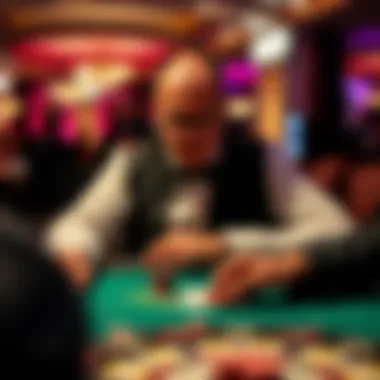
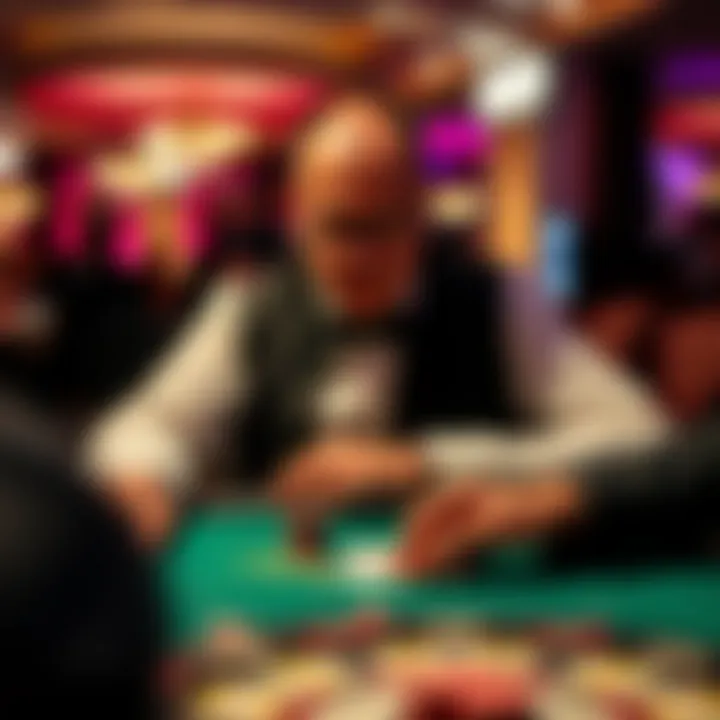
Card Counting: Theory and Practice
Card counting is an advanced technique that fundamentally shifts the balance of power from the house to the player. At its core, card counting involves keeping track of the ratio of high cards to low cards remaining in the deck. This can be crucial since a deck rich in tens and aces favors the player.
In practice, it’s about looking beyond individual hands to assess the overall game situation. For instance, if you notice a scarcity of low cards, the odds are tilted in your favor, allowing you to raise your bets with confidence.
- Understanding the Basics: The most common systems often incorporate a simple running count. You begin from zero, adding or subtracting based on the cards dealt. High cards (10s, face cards, and aces) usually add to your count, while the lower cards (2 through 6) subtract.
- Practicing Your Skills: Begin in a low-pressure environment. Play blackjack with friends or online for free initially; this way, you can hone your skills without financial strain.
Card counting is not just about numbers; it's about having a keen intuition, staying calm under pressure, and knowing when to deviate from basic strategy based on your counts.
Variations of Card Counting Systems
Card counting is not a one-size-fits-all solution. Different players have different comfort levels and skill sets, leading to various systems that can be used. Understanding these variants enables players to choose one that suits their particular style.
- Hi-Lo System: This is the classic method and widely recognized for its efficiency. It's relatively easy to learn and implement. Each card is assigned a value to keep the running count.
- KO System: The Knock-Out system is an unbalanced counting system, meaning it doesn’t reset to zero after each combination of hands. This method can be advantageous since it reduces the complexities of tracking a balanced count.
- Omega II System: This is a more complex method suitable for seasoned players. It assigns varying weights to different cards, providing a more nuanced counting strategy that can yield better results if mastered.
Bet Sizing Strategies
Understanding how to effectively change your bet size in conjunction with your card count can significantly increase your potential earnings. The trick is to balance your risk with potential reward. Here are a few strategies:
- Flat Betting: This is the simplest form of betting. Consistency here means you place the same amount every hand. While this minimizes risk, it’s less effective if you’re using counting strategies.
- Proportional Betting: This is where card counting shines. As your count rises, increase your bets in proportion to your advantage. Conversely, when the count is against you, minimize your bet size to preserve your bankroll.
- Spread Betting: This strategy allows you to lower the size of your bet during unfavorable counts while maximizing it when favorable counts arise. The goal is to take advantage of winning streaks while mitigating losses during poorer hands.
Ultimately, employing these advanced techniques can lead you closer to blackjack mastery. The marriage of theoretical knowledge with practical application is where the real growth occurs. Keep in mind, a disciplined approach is crucial to ensure that you stay in control of your gambling experience as you delve into these sophisticated strategies.
Psychological Aspects of Blackjack
Playing blackjack isn’t just about numbers and cards; it’s also about the mindset of the players. Understanding the psychological aspects of blackjack can be the difference between a solid player and a great one. In this section, we’ll delve into two vital components: reading opponents' behavior and maintaining emotional control. Each of these can serve not only as a strategic advantage but also as a buffer against costly mistakes.
Reading Opponents' Behavior
Being able to read your fellow players is a skill that goes beyond mere observation; it’s an art form that can sway the tide of your game. Keep an eye on how others at the table respond to certain situations. Are they fidgeting or appearing overly relaxed? Do they seem confident when they make a bet, or do they hesitate? Such cues can give you insight into their hands or their level of commitment to the game.
Key Points to Consider:
- Eye Contact: Look out for players who avoid eye contact, as they might be bluffed or insecure about their hand.
- Body Language: Leaning in can indicate eagerness or strength. Conversely, slumping or facing away from the table may suggest defeat or frustration.
- Betting Patterns: Take note of how players adjust their bets based on their hands. A sudden hefty wager could mean confidence.
Understanding these signals allows you to make more informed decisions—whether you should hit, stand, or perhaps double down. In blackjack, knowing when to act can mean folding or pressing on through.
The Role of Emotional Control in Decision Making
The decisions at a blackjack table aren’t just dictated by mathematics; they’re deeply influenced by how players feel in the moment. Emotional control can ultimately dictate success or failure at the table.
Emotional States to Manage:
- Frustration: If the cards aren't showing favor, players often start making rash decisions. Recognizing when your temper flares can help you tone it down.
- Excitement: Winning is thrilling, but over-excitement can lead to careless choices. Keeping a level-headed approach ensures you don’t lose your winnings in a moment of euphoria.
- Anxiety: The pressure of the game can induce anxiety. Strategies like deep breathing or a quick step back can help balance nerves and gather thoughts.
By maintaining your emotional equilibrium, you can make sound decisions even in the face of pressure. Focused minds often see more clearly, which can lead to better outcomes.
"In the long game of blackjack, your mind can be your most powerful ally or the worst enemy."
Closing Thoughts
Choosing the Right Casino Environment
Selecting the right casino environment is a pivotal factor in optimizing your blackjack success. It might seem like a minor detail, but the atmosphere and rules can make or break your experience at the table. Factors such as player behavior, dealer interactions, and even the general mood of the casino can greatly affect your strategy and decision-making process. Getting this right ensures you’re not just playing the cards but also navigating the environment effectively.
Evaluating Casino Rules and Variants
Casino rules can vary significantly, and these differences play a crucial role in shaping your winning potential. Different establishments might offer varying payout rates, rules on splitting, doubling down, and even the number of decks used can influence the odds significantly. For instance, a game with fewer decks usually tilts the odds in your favor.
When looking for a casino, take these aspects into account:
- Payout Ratio: Standard blackjack typically pays 3:2 for a natural blackjack. Some places might offer lower payouts like 6:5; that can diminish your returns.
- Doubling Down & Splitting Rules: Certain casinos are more lenient with doubling down, allowing it after splitting. This increases your options and can lead to higher payouts in favorable situations.
- Surrender Option: Check if the casino allows surrender — the practice of giving up half your bet on a bad hand can be a lifeline in some scenarios.
By evaluating these basketball-like forays into the rules, you place yourself in a better position to emerge victorious over the house, turning the game into a more advantageous endeavor.
Finding Optimal Table Conditions
Once you've settled on a casino that suits your goals, the next step is to analyze the table conditions available. This is not just about the rules; it’s also about the human element involved in the game. You might want to position yourself at a table where players have a more laid-back demeanor, as stress levels can influence your gameplay.

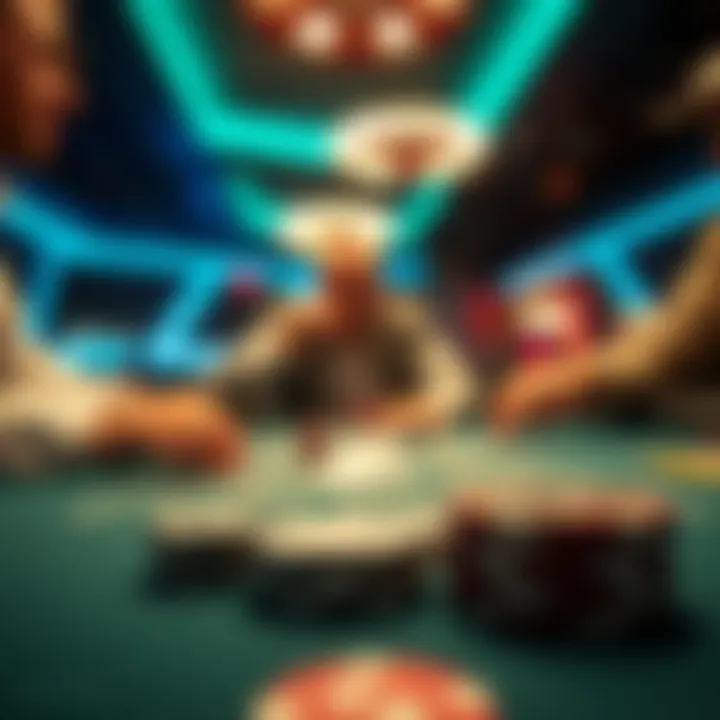
Here are a few factors to consider when choosing your table:
- Player Count: Tables with fewer players generally allow for increased betting rounds and more favorable play conditions. A heavily populated table might slow things down, compromising your strategy.
- Dealer Style: Interactions with dealers can also shape your experience. A friendly dealer might create a more relaxed environment, helping you keep your head cool during intense moments.
- Table Limits: Ensure that the table limits align with your bankroll. It’s paramount to choose a table that allows you to play without feeling pressured or uncomfortable.
Finding the right balance can transform your blackjack play into a more seamless and enjoyable experience, allowing you to focus on strategy rather than distractions.
Remember, the right casino environment creates a solid framework for your blackjack success. Choose wisely and watch your gains multiply.
Managing Your Bankroll Effectively
Managing your bankroll is as crucial to success at blackjack as knowing the rules of the game itself. Think of your bankroll as the fuel that drives your gaming engine; without it, you simply won't get very far. The better you manage your money, the more you can enjoy the game while reducing the risk of significant losses. A strong grasp of bankroll management leads not only to a more structured play style but also enhances your chances of walking away a winner.
Setting Winning and Losing Limits
Setting limits is vital; it's like drawing a line in the sand. Without establishing clear boundaries for both winning and losing, a player can find themselves lost in the thrill of the game, overspending, and quickly burning through their funds.
This strategy is simple yet effective. You might decide that when you hit $300 in winnings, you’ll cash out and call it a day. Conversely, if you lose $100, you’ll step away from the table for a while. Having these limits can keep emotions at bay. Here are a few tips for setting these limits:
- Be Realistic: Ensure your limits reflect what you can honestly afford to lose. Gambling should be seen mainly as entertainment.
- Stick Firmly: Once you set these limits, adhere to them. Ignoring your own rules can lead to regret.
- Review and Adjust: Periodically evaluate your limits based on your playing style and experience. What's working, and what isn’t? It’s alright to tweak them.
"Setting limits is not only about restraint; it’s a strategy for longevity at the blackjack table."
Dividing Your Bankroll
Dividing your bankroll into smaller, more manageable chunks can significantly impact your gameplay experience. Think of it as slicing a pizza—each slice is a manageable bite. This practice can help maintain focus and prevent you from blowing your entire stack all at once. Here are some principles to consider when dividing your bankroll:
- Choose Your Unit Size: Determine how much you’re willing to bet on each hand. For instance, if you have a bankroll of $1,000, you might decide on a unit size of $10. This allows for a good number of hands while still managing risk.
- Consider Session Limits: If you’re playing for two hours, consider dividing your bankroll into segments that reflect this time. Instead of charging in with your full amount, allocate a portion you’re comfortable using during that period.
- Use Remaining Funds Wisely: Be mindful of how you handle the surplus. Reassess where to place your bets based on your performance rather than just diving back into the game with leftover funds.
In blackjack, every decision counts, and effective bankroll management allows you to play smarter. By combining limit setting with dividing your bankroll, you're equipping yourself with tools that can lead to a more disciplined, enjoyable experience while maximizing your chances of walking away ahead.
The Role of Discipline and Patience
Discipline and patience are the backbone of a successful blackjack strategy. Often, players mistakenly assume that success at the table hinges entirely on luck or a clever trick. However, nurturing these two personal attributes can significantly tilt the odds in your favor. Discipline helps players adhere to their strategies consistently, while patience enables them to recognize opportunities without acting impulsively.
Remember, in blackjack, every decision should be well-thought-out, based on strategy rather than raw emotion. Staying disciplined allows you to stick to your plan, no matter the turmoil around the table. Players can experience the thrill of the game, but they must maintain a steady hand and clear mind under pressure.
Building a Consistent Playing Routine
Establishing a consistent playing routine is an essential aspect of mastery in blackjack. You might wonder, what exactly does that entail? It is about creating a framework that includes everything from the time you allocate for play to how you prepare mentally before sitting down at the table. Here are some crucial elements to consider:
- Set Regular Hours: Having dedicated times for playing can help build your focus. Whether it's every Friday night or more sporadically, consistency allows you to prepare mentally for the decisions you will make.
- Practice Pre-Game Rituals: Engage in rituals that help you get into the right mindset. For some, it might mean reviewing strategy charts or calming exercises, whilst others might prefer listening to music.
- Stay Within Your Limits: Stick to the bankroll you’ve set for yourself. Resist the urge to play with more than planned, as this disrupts your routine and can lead to hasty decisions.
- Reflection and Adjustment: Post-game analysis is vital. Reflecting on your performance helps identify what worked and what didn’t, leading to continuous improvement.
Recognizing When to Walk Away
Knowing when to walk away is perhaps one of the most challenging skills to master. Many gamblers often ignore the signals their instincts send, only to find themselves in a precarious situation. Recognizing those moments can protect not only your bankroll but also maintain your composure at the table. Consider these pointers:
- Loss Limits: Set clear loss limits before you start playing. Once you hit that threshold, it’s time to call it a day. Just because you’re on a losing streak, doesn’t mean you need to chase after losses; that often only leads to deeper holes.
- Winning Thresholds: Similarly, decide upon a winning amount you are satisfied with. If you reach that goal, why not cash out and relish your victory?
- Emotional State: Check in with how you're feeling throughout your session. Frustration or anger can impair judgment and lead to errant plays.
“The wise gambler knows when to bet and when to bow out gracefully.”
- Set a Timer: Sometimes, setting a timer can provide necessary breaks. Taking a moment to step away from the table allows for clearer thinking and prevents rash decision-making under the pressure of continuous play.
Discipline and patience, albeit challenging to cultivate, are central to your success at the blackjack table. By establishing a consistent routine and knowing when to step back, players set themselves up for both short-term wins and long-term satisfaction. Sources for further exploration include Wikipedia Gambling and the Britannica Guide to Blackjack.
Closure: Pathways to Success at Blackjack
In the world of blackjack, where fate and skill intertwine, drawing conclusions marks the crossroads of understanding and application. This isn’t just any game of chance; it’s a battlefield where strategies namely, patience, discipline, and informed decision-making dictate the outcome. This article meticulously outlines the skeleton of success in blackjack, but it’s the flesh — the strategies — that actually give it life.
The essential takeaway from this exploration is that mastering blackjack transcends the mere mechanic of playing cards. It requires a keen grasp of the basics, an analytical approach to advanced techniques, and a psychological fortitude to read not only the cards but also the emotions swirling in the atmosphere. Every player, whether a novice or a seasoned high-roller, can sculpt their path to success with targeted strategies, meticulous bankroll management, and an unwavering commitment to maintaining a level head.
Moreover, let's not overlook the broader implications of our findings. Having a game plan can mean the difference between leaving the casino with a smile or a frown. This extends beyond just winning; it is about smart play. Creating a meaningful connection with the strategies discussed not only sharpens your skills but also elevates the gaming experience, transforming it from simple leisure into strategy-laden excitement.
Summarizing Key Strategies
As we distill this discourse on blackjack down, a handful of vital strategies emerge as indispensable for any gambler:
- Master the Basic Strategy: This should form your foundation. Investing time to familiarize yourself with the optimal decisions based on your cards and the dealer’s upcard can't be overstated. Utilizing a basic strategy chart, which outlines the best moves in various scenarios, can significantly alter your chances.
- Understand the House Edge: Recognizing how much the house leans into its favor will assist you in crafting a plan to counter that year's edges strategically.
- Control Your Bankroll: Set winning and losing limits before stepping onto the casino floor. This is vital in maintaining your financial health and preventing emotional gambling.
- Read the Table Dynamics: Watching your fellow players and the dealer will offer insights into behaviors and trends that could inform your decisions.
- Exercise Emotional Control: A calm mind is paramount. Avoid making knee-jerk reactions after a bad hand; instead rely on your strategies and discipline.
By focusing on these key areas, players can significantly increase their probability of success, minimizing losses while maximizing potential wins.
Future Trends in Blackjack Strategies
The world of blackjack is as dynamic as a game of cards itself. As technology and gaming strategies evolve, so too will the approaches players use to slice through the competition:
- Online Blackjack Platforms: The rise of technology has resulted in the booming popularity of online casinos. Future strategies will likely incorporate facets unique to virtual play, such as live dealer interactions and smart betting algorithms designed by AI. Players must adapt to this shift without losing sight of traditional strategies.
- Data Analytics: As data mining emerges within the gambling context, some players will start using software to analyze their hands and predict outcomes based on historical data. Tools that help players better understand their statistics could reshape how strategies are devised and implemented.
- Mental Conditioning: More attention will be placed on the psychological aspects of playing. Expect to see more resources aimed at helping players build their mental game, focusing on emotional resilience.
- Adaptability and Flexibility: Future strategies will necessitate a quicker adaptability to the game’s environment and the behavioral tendencies of other players. The successful player will not just follow a rigid rule chart but will read the room effectively.
By remaining cognizant of these evolving trends and integrating them into their arsenal of tactics, players can further improve their odds of triumph. After all, as the wheel of time turns, so too do the strategies that fuel this ever-engaging card game.







